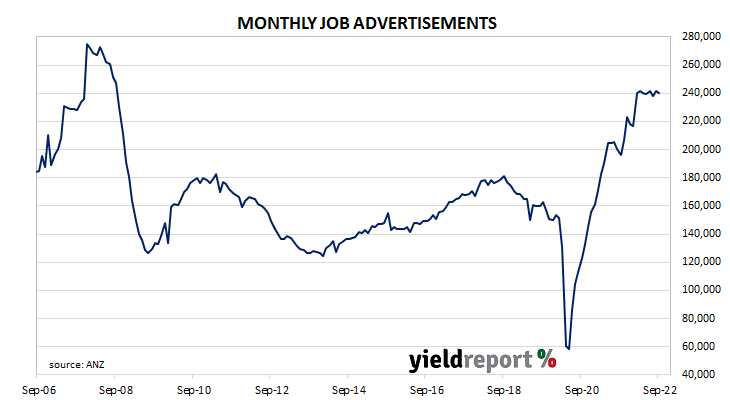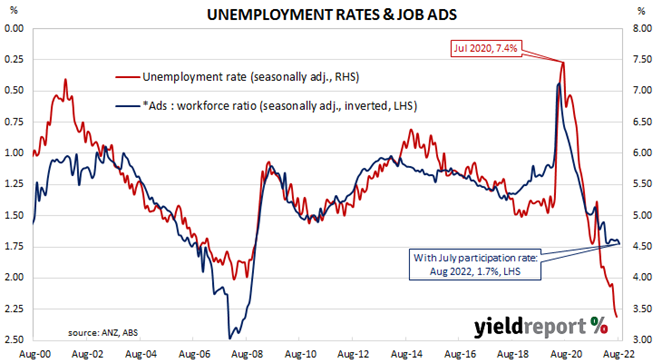Summary: Job ads down 0.5% in September; 22.3% higher than September 2021; advertisements “holding up well” several months into rate hike cycle; RBA may have to take cash rate further into restrictive territory to slow demand growth; ads-to-workforce ratio steady at 1.7%.
From mid-2017 onwards, year-on-year growth rates in the total number of Australian job advertisements consistently exceeded 10%. That was until mid-2018 when the annual growth rate fell back markedly. 2019 was notable for its reduced employment advertising and this trend continued into the first quarter of 2020. Advertising plunged in April and May of 2020 as pandemic restrictions took effect but then recovered quite quickly.
According to the latest ANZ figures, total advertisements decreased by 0.5% in September on a seasonally adjusted basis. The fall followed a 1.5% gain in August and a 1.7% decline in July after revisions. On a 12-month basis, total job advertisements were 22.3% higher than in September 2021, up from August’s revised figure of 20.3%.
“It shouldn’t be a surprise that ANZ Job Ads is holding up so well several months into the rate hike cycle,” said ANZ senior economist Catherine Birch. “New Zealand’s job ads series, Jobs Online, is yet to turn down, despite the RBNZ commencing tightening seven months earlier than the RBA.”
The figures were released on the same day as the RBA’s smaller-than-expected 25bps increase of its cash rate target and Commonwealth Government bond yields fell significantly. By the close of business, the 3-year ACGB yield had shed 34bps to 3.34%, the 10-year yield had lost20bps to 3.75% while the 20-year yield finished 13bps lower at 4.04%.
In the cash futures market, expectations regarding future rate rises eased considerably. At the end of the day, contracts implied the cash rate would rise from the current rate of 2.56% to average 2.78% in November and then increase to an average of 2.93% in December. May 2023 contracts implied a 3.555% average cash rate while August 2023 contracts implied 3.565%.
“The fact that ANZ Job Ads and other leading indicators of Australia’s labour market are still so strong suggests the RBA may have to take the cash rate further into restrictive territory than we currently expect to slow demand growth,” explained Birch.
The inverse relationship between job advertisements and the unemployment rate has been quite strong (see below chart), although ANZ themselves called the relationship between the two series into question in early 2019. A rising number of job advertisements as a proportion of the labour force is suggestive of lower unemployment rates in the near future while a falling ratio suggests higher unemployment rates will follow. September’s ads-to-workforce ratio remained unchanged at 1.7%.
In 2008/2009, advertisements plummeted and Australia’s unemployment rate jumped from 4% to nearly 6% over a period of 15 months. When a more dramatic fall in advertisements took place in April 2020, the unemployment rate responded much more quickly.



